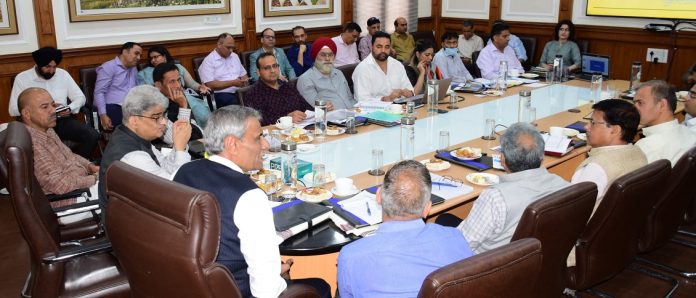JAMMU: In a major push towards harnessing the emerging technologies for governance and development, Chief Secretary, Atal Dulloo, today chaired a high level meeting to deliberate on collaboration with the Bhaskaracharya National Institute for Space Applications and Geo-Informatics (BISAG-N) for establishing a Centre of Excellence in the Union Territory.
The meeting was graced by Director General, BISAG-N, T.P. Singh and Special Director General, BISAG-N, Dr. Vinay Thakur, who presented an overview of potential technological interventions, ongoing national projects and the institutional framework being followed in other states.
The proposed structure of the Centre of Excellence (CoE) in J&K was discussed in detail, aligning with the Government of India’s vision under the Ministry of Electronics and Information Technology (MeitY) and its flagship India AI Mission, which promotes AI and digital innovation across governance sectors.
The Chief Secretary emphasised that J&K must emerge as a national example in applying Artificial Intelligence (AI), Machine Learning (ML), Cloud Computing and GIS-based decision making in governance. He called upon the departments to identify priority areas that could benefit from BISAG-N’s expertise. He directed for preparing a formal proposal for submission to MeitY at the earliest. He also suggested for exploring collaboration with IIT Jammu for capacity building and knowledge partnership.
Speaking on the occasion, T P Singh, Director General, BISAG-N, highlighted the need for outcome-driven implementation with clear, measurable timelines. He further emphasised the importance of engaging the local youth in development and implementation to ensure sustainability and skill development in the region.
Special DG, BISAG-N, Dr. Vinay Thakur, spoke on BISAG-N’s national level initiatives and offered support to Jammu and Kashmir in designing bespoke applications based on departmental requirements.
A potential Memorandum of Understanding (MoU) between the UT Government and BISAG-N was also discussed, with the Chief Secretary directing that all modalities be finalised at the earliest to kick-start the implementation.
The meeting was attended by Additional Chief Secretary, Higher Education and Financial Commissioner, Shantmanu; Additional Chief Secretary and Financial Commissioner Revenue, Shaleen Kabra; Principal Secretary, Power Development Department, H. Rajesh Prasad; Principal Secretary, Finance Department, Santosh Dattatraya Vaidya; Commissioner Secretary, Science & Technology Department, Saurabh Bhagat; Commissioner Secretary, General Administration Department, M. Raju; Commissioner Secretary, Tourism Department, Yasha Mudgal; Director, Industries & Commerce, Arun Kumar Manhas; Deputy Director, Social Welfare Department, Sanna Khan and other senior officers of the administration.
The Chief Secretary expressed gratitude to BISAG-N for its support and affirmed that this collaboration would serve as a transformative leap towards digital governance and technology-led growth in Jammu and Kashmir.
Administrative Secretaries and senior officers of various departments presented comprehensive inputs on potential areas of collaboration. These included digitisation, automation and real-time updation of land records and records of rights in the Revenue & Land Records department.
In Tourism, they discussed real-time tourist facilitation, analytics for tourism augmentation and smart management of tourist flows. The Power Development Department could benefit from monitoring power purchases and reducing transmission and distribution losses using predictive analytics.
For Industries & Commerce, early warning systems for MSMEs in distress and improving service delivery frameworks were proposed. The GST and the Finance department could utilise AI-based anomaly detection systems to identify and prevent tax fraud.
In Jal Shakti & Irrigation, flood monitoring, water resource mapping and irrigation network optimisation through satellite imagery and AI models was considered.


